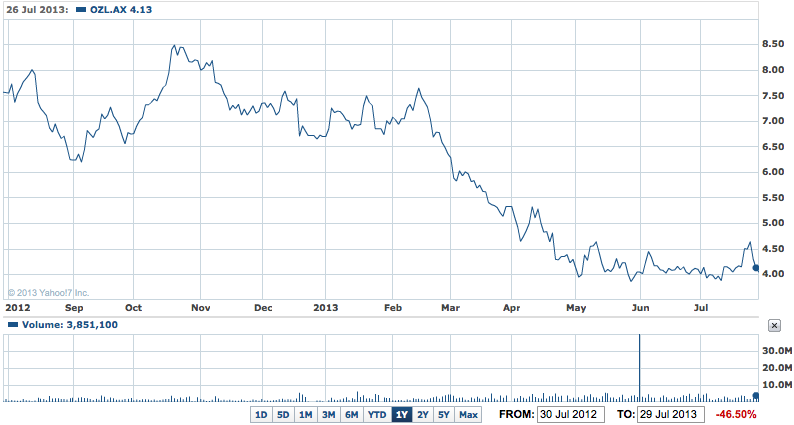OZ Minerals (OZL) surprised shareholders yesterday with news of a $240 million write down due, in part, to lower copper and gold prices and a landslip at one of its mines in outback South Australia.
The impairments, announced in an early statement to the market, left some shareholders wondering by the company didn’t announce them last Thursday, in conjunction with the June quarter production report.
Directors gave the clear impression this was a prudent write-down, given the short term outlook for copper prices. They also made clear the impairment would have no impact on gearing levels because OZ has no debt.
OZ said it expects its six monthly earnings results, due next month, to show a non-cash asset impairment charge of between $200 million to $240 million after tax (or well over $300 million pretax).
The company last week cut its production guidance for 2013 to between 120,000 ounces to 130,000 ounces of gold, from the previous range of 130,000 to 150,000 ounces, as a result of the landslip.
OZ retained its guidance for copper production of between 82,000 to 88,000 tonnes, with most of the production to come in the second half of the year.
Shares in OZ Minerals dropped more than than 6% last Thursday, after the lower production guidance was announced.
OZL 1Y – OZ Minerals reveals new write down in asset values, but no debt stress

They fell a further 8c, or 2.2% yesterday on the latest news to close at $4.05. Since last Wednesday, OZ shares have lost 69c or around 15%.
Shareholders seem to be losing confidence in the board and management.
The company said the impairment charge was due to a combination of factors including: lower than expected copper and gold prices, development work and a landslip at its Malu mine in South Australia. The pit returned to normal operation earlier this month.
Directors explained in the statement:
"The anticipated asset impairment has arisen due to a combination of factors, including: Lower expected prices for copper and gold, particularly in the near term; OZ Minerals relies on a consensus forecast to set these assumptions and; recently there has been a significant reduction in forecast prices.
"(The) Lower A$/US$ exchange rate forecast in line with the same consensus, which has had a beneficial effect (on the copper price).
"Higher asset values as a result of capitalisation of work towards developing the New Malu Underground mine, capitalisation of deferred waste movements in the Malu open pit which are currently at a peak level, and capitalisation of the work conducted to remediate the south wall overburden slip in the open pit.
"As a result, the carrying value of assets as at 30 June prior to impairment are expected to be in a range of $1,585 million and $1,625 million."
OZ pointed out that a previous impairment charge in late 2008 of $251 million post tax "was taken against the Prominent Hill asset, following the impact on commodity price outlook following the GFC. This impairment was subsequently reversed in June 2010 when the outlook for commodity prices improved."
"As noted, the anticipated asset impairment charges are non-cash in nature and significant remaining work is required to finalise the amount. As the company has no drawn debt, the impairment won’t affect the company’s gearing levels."
NOTE: OZ Minerals was one of the final bidders for Rio’s Northparkes mine (See separate story). Analyst response to its failure to win the mine in the auction this morning seems to be generally positive as many had valued the mine at a lot less than the $US820 million paid by the Chinese buyer.
That might be a small positive for OZ as it prepares to report some below average figures for the first half and confronts more of the same in the coming six months, offset by the benefit of a weaker Aussie dollar.













